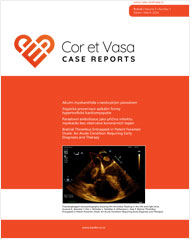 Cor et Vasa Case Reports
Cor et Vasa Case Reports
Svazek | Volume 7 • Číslo | Number 1
Březen | March 2024

K. Gottwaldová, M. Houra
We present a case report of a 30-year-old man, who was admitted to the internal department for chest pain with suspected cardiac aetiology along with ongoing acute gastroenterology with fever. The diagnosis of acute myocarditis was based on echocardiography, elevation of cardiomarkers, inflammatory markers, and exclusion of ischaemic aetiology by selective coronarography. The positivity of antibodies against Rickettsia conorii was serologically confirmed. Furthermore the magnetic resonance imaging was performed. The late enhancement confirmed by the magnetic resonance imaging, second serology, and good effect of antibiotic treatment (doxycyclin) confirmed the diagnosis. The presented case report is uncommon with its presentation – an absence of typical exanthema, the presence of gastrointestinal symptomatology, and myocardial impairment in a patient without any risk factors.

O. Dvořáková, V. Kaučák, R. Brát, V. Kiš
In this paper, we describe a case of a 73-year-old female patient hospitalized for progressive exertional dyspnea and chest tightness. During the diagnostic procedure, a massive thrombus in the left ventricle as well as various forms of cardiomyopathy (non-compaction cardiomyopathy, endomyocardial fibrosis) were suspected. Finally, a surgical procedure was performed, revealing hypertrophic cardiomyopathy with a unique extent and growth rate. Although magnetic resonance imaging is the most valuable tool available for the diagnosis of cardiomyopathies, this method also has its limitations and may lead to incorrect conclusions.

J. Pavlas, J. Mohr, J. Walder
The diagnosis of myocardial infarction (MI) with no obstructive coronary atherosclerosis (MINOCA) in a patient without any known risk factors may be difficult to establish and, in particular, it can be difficult to choose the correct treatment. Here, we present a case of a young woman (43) presenting with clear signs of MI with no clear cause. After using a wide range of diagnostic methods, which revealed a persistent foramen ovale (PFO), paradoxical embolization was finally concluded to be (despite its rarity) the most likely cause of the patient’s condition. Based on this, the patient was treated with a therapeutic anticoagulant dose and subsequently, after her problems resolved, a PFO closure was performed. The patient is currently free of any problems. The presented case highlights the importance of a wider differential diagnosis and of an individual approach to the patient in cases that are not entirely common.

K. Luxová, T. Novotný, L. Koc, J. Ničovský, A. Tomášek, L. Křikavová, P. Kala
Patent foramen ovale occurs in up to 20% of adults and is associated with a higher risk of paradoxical embolization when a thrombus enters the systemic circulation through a shunt. The thrombus can also wedge in the foramen ovale. It is a rare condition associated with high mortality, and early diagnosis and treatment are essential. In this case report, we present a 37-year-old woman with a thrombus entrapped in the foramen ovale with bilateral massive pulmonary embolism, and paradoxical embolization to the arteries of both lower extremities. There are no uniform guidelines regarding therapy. According to available case reports and reviews, surgical thrombectomy for a thrombus entrapped in the foramen ovale is preferred. Depending on the patient’s condition, thrombolytic or anticoagulant therapy may be considered.